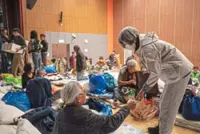A view of the Iver glacier close to the El Plomo mountain summit, in the Andes mountain range, in the Santiago Metropolitan Region, Chile. The glacier-capped Andean peak revered for centuries, with the Incas carrying out human sacrifices at the summit, is crumbling. — Reuters
CHILE’s towering El Plomo mountain, a 5,400m Andean peak visible from Santiago, has been revered for centuries.
The Incas used its summit for human sacrifices, and an Incan mummy, preserved by the dry, cold conditions, was found near the top in 1954.





